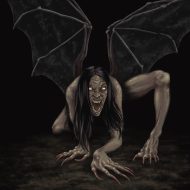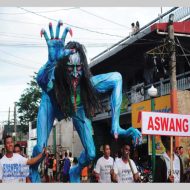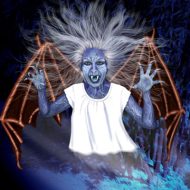Aswang : The Shapeshifting Vampire
At a glance
| Description | |
|---|---|
| Origin | Philippine Mythology |
| Classification | Ghosts |
| Family Members | N/A |
| Region | Philippines |
| Associated With | Bloodsucking, Shapeshifting |
Aswang
Introduction
In myth and legend, aswang are beings that exhibit similar grotesque traits to werewolves and vampires, featuring varied appearances with no consistent image. Often described based on word of mouth, aswang is a broad term encompassing malevolent spirits typically associated with nocturnal activities.
These creatures typically evade notice during daylight, seamlessly blending in with the ordinary people around them as they discreetly seek their next victim. Many are linked to women, often identified by their long, dark hair concealing bloodshot eyes.
The origins of aswang tales trace back to the 16th century when Spanish explorers documented their encounters with these entities in writing. It’s possible that these narratives originated from the supernatural beliefs of the Philippines’ Malay communities, brought along by the Spanish explorers. Accounts from the 16th century suggest that the local people, as perceived by Spanish conquerors, amplified the fear surrounding aswang to an extreme degree.
Physical Traits
Aswang are commonly perceived as nocturnal predators that hunt humans under the cover of night. They often take the form of a dog, cat, or bird, patiently awaiting their prey to be isolated. According to experts, direct eye contact with someone might reveal an aswang. An expedient method of identification involves using a special oil crafted by a Filipino witch doctor, known as an albularyo, which has the peculiar property of boiling in the presence of the creature.
While encountering aswang during daylight is not a guarantee, they are believed to be at their weakest state during this time, rendering them incapable of causing harm. Typically linked with women, they are characterized by long, black hair. Aswang are said to possess inverted feet, a distinctive giveaway, and they instinctively avoid bright lights and loud noises.
Family
Typically, most pairs of aswang do not stay together during the night, increasing the likelihood of solo hunting. Their unity can also be disrupted if they don’t share food. A method for becoming an aswang involves tying a chicken egg to the stomach. After the egg passes through the body, it’s placed in a bamboo tube filled with chicken manure and coconut oil.
Upon their demise, the aswang’s powers are transferred to another entity. This transference occurs by allowing a chick to move from one stomach to another through their mouths. Aswang can be neutralized using various items like garlic, salt, water, a rosary, or a crucifix. Another method involves using the tail of a stingray to whip them, as they are averse to the slashing sound, potentially resulting in their demise.
Other names
Aswangs manifest in diverse forms. The zegben can shape-shift into a Tasmanian devil, while the tik-tik, named after the sound it produces, transforms into large birds or bats. A woman who appears ordinary during the day becomes a manananggal at night, consuming fetuses. This creature can detach its torso, sprout wings, and morph into a bat. The busaw specializes in grave robbing and corpse thievery, scavenging from the remains of the deceased in cemeteries. The Bubuu aswang, characterized by bloodshot eyes, emits a sound akin to a laying hen during the night.
Powers and Abilities
One of the most unsettling aspects of aswang is their ability to blend in unnoticed during daylight hours, making them inconspicuous among people. They select their victims under the cover of night, embodying a chilling combination of witch, vampire, and beast. The notion that they can seamlessly coexist with humanity without detection adds to the terror.
Aswang are infamous for consuming flesh, with a particular preference for children and fetuses. Reports describe them possessing a proboscis-like tongue, which they employ to extract blood from the womb. Nightly, they embark on a hunt for their next meal in the small towns of the Philippines.
These creatures employ various sounds to deceive their prey, including a repetitive “tick.” As they draw near, the sound diminishes, creating the illusion that the creature is receding and luring their victims into a false sense of security.
Modern Day Influence
As aswangs are renowned shape-shifters, animals commonly associated with humans are sometimes misconstrued as aswang due to their distinctive sounds. This misbelief has led to the unfortunate killing of animals such as bats, flying lemurs, and Tasmanian devils.
A plausible explanation for the legend of aswang is its purported origin in the Capiz region. Filipino men, susceptible to a rare genetic condition known as XDP, experience uncontrollable muscle movements and spasms reminiscent of aswang depictions.
Additionally, aswang may serve as a convenient scapegoat for individuals committing gruesome murders. Many find it easier to attribute such acts to a mythical monster than to grapple with the complexities of understanding why a fellow human could commit such heinous acts. Tabloids exploit the aswang narrative to boost sales, capitalizing on the sensationalism surrounding these stories.
Related Images
Frequently Asked Questions
What does aswang do to humans?
Aswangs are shapeshifting monsters in Philippine myth. Feared for their taste for human blood and flesh, they especially target pregnant women and babies. They lurk in darkness, disguising themselves and using trickery to lure victims close. Aswangs are a terrifying reminder of the dangers that can hide in plain sight.
Is aswang real in the Philippines?
Aswangs are creatures of Philippine folklore, not reality. There’s no scientific evidence to support their existence. However, these myths are very much alive in Filipino culture.
What are the 5 types of aswang?
What is the difference between Manananggal and aswang?
What kills an aswang?
Aswangs hate the sun, so dawn is your best bet. Garlic and salt repel them like flies. Strike their back true, or a shaman’s magic might subdue!












